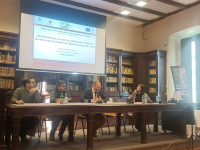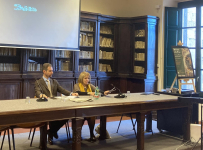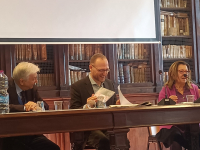The main results of the research conducted by the DisComPoSE team in the historical-linguistic field were presented during the international conference Before the end. Culture and politics of calamity in the early modern age, which took place in Naples on December 18th and 19th 2023.
Andrea Mazzucchi, Director of the Department of Humanities of the University Federico II, Renata De Lorenzo, President of the Società Napoletana di Storia Patria, and the P.I. Domenico Cecere summarized a collaborative and multi-year research experience that focused on the pivotal role of disaster information in the evolution of cultural frameworks, social relations, and power structures of the Ancien Régime societies.
During the early modern period, there was a progressive increase in attention towards natural disasters both inside and outside the halls of power. By stimulating the search for news and explanations, the outbreak of extreme natural phenomena fostered social interaction and expanded communication channels. An important vehicle for disseminating news of these events was printed reports.
Chiara De Caprio, Annachiara Monaco, and Valentina Sferragatta illustrated how disaster reports generate particular interest from a linguistic point of view because, in addition to informing readers, they emphasize the extraordinariness and novelty of what happened to place it within a religious and moral interpretive framework.
Through the analysis of a corpus of printed reports on eruptions, earthquakes, and floods published between the sixteenth and seventeenth centuries, Francesco Montuori and Rosa Anna Paradiso explored the pre-scientific vocabulary used to describe eruptive phenomena before the birth of volcanology.
With his contribution on the peculiar characteristics of flood narratives, Gennaro Schiano highlighted the responsibilities of the institutions called upon to implement much more advanced and well-known management and prevention practices compared to those for earthquakes and eruptions.
Along with the success of “relaciones” in seventeenth century Spain, the circulation of periodic gazettes also began to consolidate, characterized by their own narrative strategies, rhetoric, and topoi functional to the narration of the event, as recalled by Vincenzo Leonardi.
The stylistic analysis of poetic production in Italian and Latin was conducted by Antonio Perrone, who highlighted the affinities between poetic compositions, reports, and seventeenth century visual culture.
In the realm of sacred prose, Davide Di Falco focused on the rhetorical and lexical characteristics of a corpus of panegyrics in Italian. Antonietta Molinaro, on the other hand, concentrated on analysing recurring themes in verses about disasters composed by seventeenth century Spanish poets.
In the varied array of artistic representations centred on disasters occurring in the early modern era, a central place is occupied by religious images, through which the providential view that considered earthquakes, eruptions, and floods, as well as epidemics and famines, as manifestations of God’s wrath was expressed. Milena Viceconte explored the most recurrent iconographies in the Neapolitan, Sicilian, and Spanish contexts between the seventeenth and eighteenth centuries.
Religion, in fact, emerged as a fundamental interpretative line of calamitous phenomena in early modern society. Beatriz Álvarez García examined sermons, prayers and supplications produced in the aftermath of various disasters, identifying the interests of religious orders and the ecclesiastical hierarchy that were often underlying such interpretations.
The study of earthquake management that emerges from the rich correspondence of the Secretary of State of the Holy See with the apostolic nuncios and bishops allowed Alessandro Tuccillo to investigate significant aspects concerning political and intellectual history, and the history of institutions.
Umberto Signori demonstrated that the earthquakes and eruptions that struck Pozzuoli, Catania, and Syracuse between 1536 and 1542 did not prompt emergency administrative responses from the respective vice-regal governments, although some measures were taken against the depopulation of the damaged areas.
There was also an inquiry into what it meant for the Spanish Monarchy to face natural disasters occurring in colonial territories. Referring specifically to the Guatemalan context, Matteo Lazzari reflected on the responses to emergency situations and the narratives that accompanied the creation of policies aimed at managing traumatic events during the chronological period considered.
The conference concluded with a keynote lecture by Virginia García Acosta, who highlighted that, unlike European languages, there was no equivalent term for ‘disaster’ in indigenous and Mesoamerican languages. This suggests a conception of disasters not so much as natural events, but as processes influenced by social, cultural, and institutional logics.











